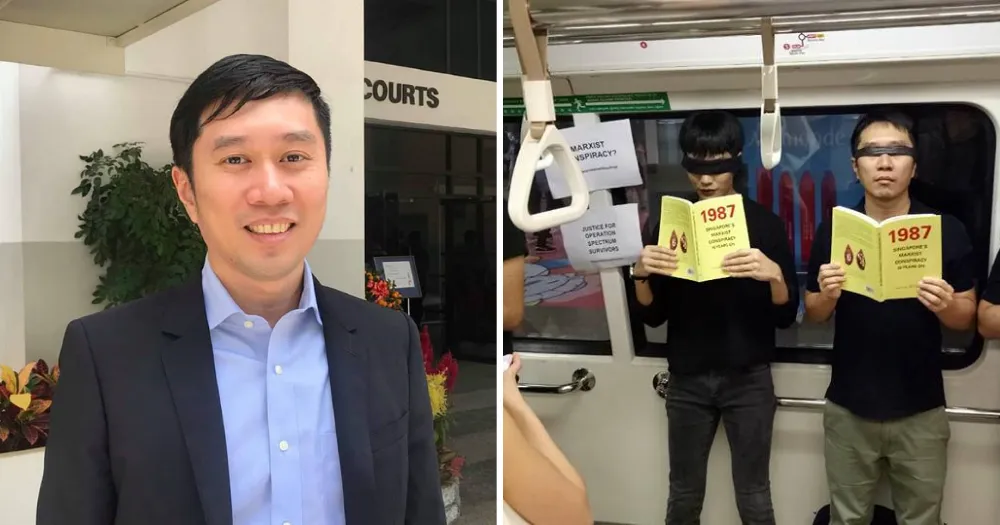范国瀚未缴因2017年地铁抗议被判的8000 新元罚款而选择 22 天刑期
他将入狱服刑 22 天。
|1 min read

<p>周一(2月15日),新加坡活动人士范国瀚(Jolovan Wham)被判未经许可组织公众集会,违反了《公共秩序法》(Public Order Act)。</p> <p>他还被判犯有一项破坏公物罪和一项拒绝向警察签署声明罪,且合并控罪另外两项罪行。</p> <h2 id="8000" class="“headings“">被罚8000 新元,他改选坐牢</h2> <p>据新加坡警察局(SPF)称,范国瀚被处以8000 新元总罚款,或 32 天监禁。</p> <p>范国瀚周一下午在社交媒体上发表了一份声明,表示他将对这些指控认罪。</p> <p>新加坡活动人士、记者韩俐颖(Kirsten Han)在推文中表示,范国瀚因拒绝签署警方声明而支付了罚款。</p> <p>他将被判处 22 天监禁以代替支付剩余罚款,其中 18 天是因未经许可组织公众集会, 4 天是因破坏公物罪。</p> <h2 id="operation-spectrum" class="“headings“">要求对“光谱行动”(Operation Spectrum)作出回答的无声地铁抗议</h2> <p>新加坡警察局称,这三项指控包括未经许可组织公众集会、破坏公物以及拒绝签署警方声明,都与范国瀚2017年在地铁上组织的无声抗议有关。</p> <p>这次示威活动是为了纪念“光谱行动”30周年而举行的。在1987年,22名被政府指控策划马克思主义阴谋来推翻国家的人未经《内部安全法》(Internal Security Act)审判而被拘留。</p> <p><img src="https://imgur.com/igWEABG.jpg"></p> <p>照片中,几名通勤者包括范国瀚手持《1987年:新加坡马克思主义阴谋30年后》一书。</p> <p>他们旁边还有几张印着“马克思主义阴谋,”和“为光谱行动幸存者伸张正义”字样的纸。</p> <h2 class="“headings“">警方调查</h2> <p>根据警方发布的新闻,接到范国瀚在Facebook上发布抗议的相关报告,警方随后在2017年6月3日(地铁抗议事件的第二天)展开调查。</p> <p>调查显示,范国瀚向至少5人分发了《1987年:新加坡马克思主义阴谋30年后》和眼罩。</p> <p>当中有六人加入了范国瀚在地铁上的抗议,在那里他们被拍到看书的照片。</p> <p>警方称,另外两人还拍照并回答了公众的提问。</p> <p>范国瀚在他发布的社交媒体帖子中表示,该小组聚集在一起是为了纪念“光谱行动”30周年。</p> <h2 class="“headings“">被控未经许可组织公众集会和破坏公物罪</h2> <p>据新加坡警察局称, 范国瀚被指控在未经许可的情况下组织公众集会,因为根据《公共秩序法》第2条,为纪念某一事件而举行的集会或会议被定义为集会。</p> <p>警方指出,范国瀚未获准组织这次集会。</p> <p>除了未经许可组织公众集会外,范国瀚还被控破坏公物罪。</p> <p>相关的破坏公物行为是他贴在地铁侧边上的两张纸,上面写着“马克思主义阴谋,#未经审讯而监禁”和“为光谱行动幸存者伸张正义 #未经审讯而监禁”。</p> <p>范国瀚被判的另外两项罪名是,2017年7月13日(也就是被判有罪的贩毒分子Prabagaran Srivijayan被处决的前一天晚上)在樟宜监狱外组织守夜活动,以及拒绝在他提交给警方的供词上签字。</p> <h2 class="“headings“">屡次“公然无视”和“蔑视法律”</h2> <p>根据警方的声明,范国瀚“一再表现出公然无视和蔑视法律”,并表示,他“本可以通过在洪林公园(Hong Lim Park)的“演说者之角”(Speakers' Corner)举行抗议或在网上发表自己的观点来合法行使政治表达权”。</p> <p>“演说者之角是在满足某些条件的前提下新加坡人表达自己观点和举行公众集会的合适场所,无需获得许可。</p> <p>鉴于新加坡人口稠密,允许在演说者之角或其他有许可的地方举行公开抗议,可以让当局评估和管理公共秩序风险。”</p> <p>据亚洲新闻台报道,地区法官Marvin Bay表示,“与之前的犯罪行为相比,这起案件有一定程度的升级”,因为它超过了大约两个小时的“延长”时间,而且“有一定程度的计划和准备”。</p> <p>Bay指出,抗议者基本上没有表现出“好战或公开的敌对”,而且他们似乎避免了拥挤的地铁。</p> <p>他还表示,他“注意到”抗议者撤掉了他们的标志,并且“他们除了在地铁上短暂停留外,没有造成财产损失和留下任何标记”。</p> <p>但根据亚洲新闻台的文章,他说抗议者的行为会在通勤者中造成混乱和“一定程度的焦虑”。</p> <p>新加坡警察局声明:</p> <p>“政府对非法示威和抗议采取零容忍态度,因为这些行为可能导致公共秩序事件。</p> <p>对公开抗议的管制让政府能够维护公共秩序,确保社会的和平与稳定。”</p>

